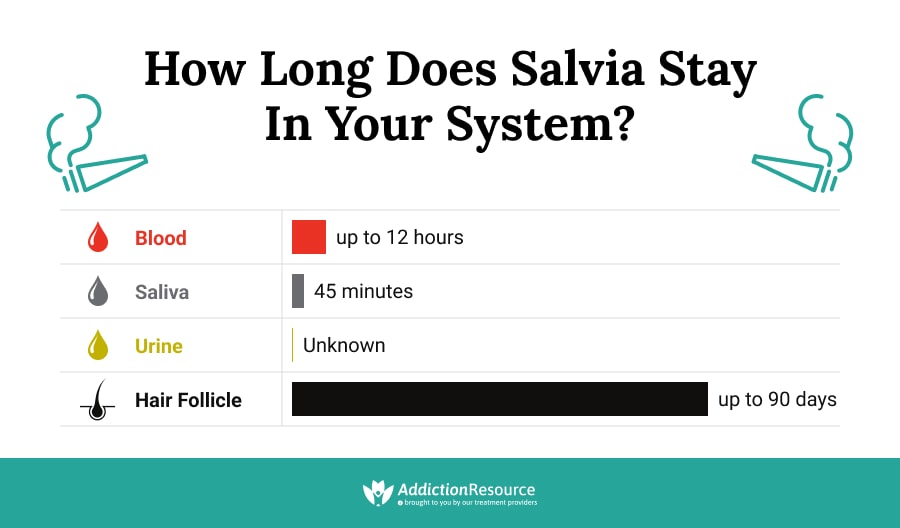Salvia divinorum, a member of the mint family, is an herbal plant native to the southwest region of Mexico. Traditionally, preparations of this plant have been used to treat illnesses, particularly those associated with inflammatory conditions and pain.
Today, S. divinorum extracts have gained popularity in various countries as a recreational drug due to their potent hallucinogenic effects. Salvia’s active component, salvinorin A, acts as a potent agonist at brain receptors, leading to distinctive psychedelic experiences.
As public awareness of S. divinorum grows, you may wonder: Is salvia bad for you? Keep reading to learn about Salvia effects on the human body, the factors that influence its duration, and the methods used to detect it.
Table Of Contents:
Is Salvia A Drug?
Salvia, also known as magic mint, is the common name for the hallucinogenic plant Salvia divinorum. This short-acting hallucinogenic herb is considered a drug due to the psychoactive effects of its active component, salvinorin A.
In the U.S., Salvia is not regulated under the Controlled Substances Act, but some states have passed their own laws, and others have proposed legislation against it. As of today, Salvia is illegal in 29 states.
As a recreational drug, Salvia is typically either smoked or chewed. When smoked, the leaves are dried and inhaled, leading to a rapid onset of effects. Chewing the leaves allows the active component to be absorbed through the mucous membranes in the oral cavity.
Salvia Mechanism of Action
Unlike traditional hallucinogens that act on serotonin receptors, salvinorin A is a potent and selective agonist of the κ-opioid receptors (KORs) in the brain. This unique mechanism of action separates Salvia from other hallucinogenic substances, such as LSD or psilocybin.
The κ-opioid receptors are a type of opioid receptor that, when activated, can produce a range of effects, including analgesia, dysphoria, and hallucinations. KORs are distributed throughout the brain, with significant concentrations in perception, mood regulation, and pain processing areas.
After an intake of an aqueous preparation of crushed Salvia divinorum leaves, salvinorin A triggers a cascade of neurochemical events, including:
- Short-lasting light-headedness
- Dysphoria, tactile and proprioceptive sensations or kinesthesia
- A sense of depersonalization and derealization
- Amplified sound perception
- Increased visual and auditory imagery
Modern consumption often involves leaf extracts with increased concentrations of salvinorin A, commonly sold online. These extracts produce a potent hallucinatory effect, with the reported hallucinogenic dosage of salvinorin A in humans being 250–500 µg (0.25–0.5 mg).
Its potency is slightly inferior to the well-known synthetic hallucinogen LSD. The rise in Salvia’s recreational use and its associated risks has led to growing concerns and stricter regulations.
How Long Does Herbs Stay In Your System?
In this case, Salvia as a drug and its active component, Salvinorin A, are highly lipophilic, allowing them to cross the blood-brain barrier rapidly. When smoked or vaporized, they reach the brain almost immediately (3.3% of the dose in 40 s), leading to a swift onset of effects. When chewed, the absorption through the oral mucosa is slower but still effective.
However, there are factors affecting how long salvinorin stays in the system, including:
- Body mass: Greater body mass can prolong a drug’s half-life.
- Dosage and duration: Higher doses and long-term use increase half-life and presence in the system.
- Type of ingestion: Smoked or vaporized Salvia tend to have a shorter half-life.
- Health status: Poor kidney or liver function slows elimination, making it stay longer in the system.
- Interactions: Co-use with substances like alcohol can extend Salvia’s half-life and slow its metabolism
Salvia Half-Life
Another important factor is the drug half-life. To better understand how long it takes for Salvia to get out of your system, it’s helpful to consider Salvia half life.
A drug’s half-life is the time it takes for the concentration of the drug in the bloodstream to be reduced by half. This measure determines how long a drug’s effects will last, how often it needs to be administered and how long it might be detectable in the body.
The half-life of Salvia divinorum’s active component, salvinorin A, has been reported to range from 40 minutes to 1.5 hours. However, these half-life characterizations are based on single-dose administration. Descriptions of the Salvia side effects after chronic use are currently unavailable in the literature.
How Long Does Salvia Last For?
The complete elimination of a drug from the body can be estimated using its half-life. Typically, it takes about 4 to 5 half-lives for a drug to be eliminated from the system. To calculate a salvia trip length, we can follow the next formula:
Complete Elimination Time = Half-Life × 5
- For the lower end (40 minutes converted to hours equals 0.67)
Complete elimination time = 0.67 hours × 5 = 3.35 hours
- For the upper end (1.5 hours):
Complete elimination time = 1.5 hours × 5 = 7.5 hours
Based on its elimination half-life of 1.5 hours, it would take approximately 7.5 hours for Salvia to be completely eliminated from your system.
Does Salvia Show Up On A Drug Test?
Several medications can cause false-positive results in urine drug tests. This happens because these drugs can interfere with the immunoassay methods used in standard drug testing, leading to the mistaken identification of other substances.
Yet, this is not the case for Salvia. First, the Salvia divinorum drug has not been trialed or approved for treatment, and testing is somewhat complicated and expensive because standard drug tests can’t detect its active ingredient, salvinorin A. Specialized Salvia tests are rare and mainly available in states where the plant is illegal.
Exceptions include certain government drug tests, like the US Army, that conduct screenings nationwide. Salvia is not included in the typical 5 or 10-panel employment drug tests.
Salvia Drug Tests and Detection Window
The detection window for Salvinorin A, the active component of salvia the drug, varies widely across different screening methods.
Gas chromatography, liquid chromatography, high-performance liquid chromatography, mass spectrometry, and atmospheric pressure chemical ionization are advanced techniques used to detect the presence of Salvinorin A in the body.
Standard detection times for Salvia are outlined below:
- Blood: 12 hours after intake
- Hair: 90 days after chronic ingestion
- Urine: Not enough information, lack of studies
- Saliva: 45 minutes after intake

Salvia Addiction
Data on Salvia divinorum addiction is still limited, but some trends have been observed. Research has documented that salvia use rates are highest among young adults.
A study found that 3.5% of incoming first-year college students in the U.S. reported using salvia in the past two weeks. Among these users, 34.3% had used salvia under the influence of marijuana in the past month. Alcohol use significantly predicted salvia use, and co-use with marijuana was common.
There have been cases of severe Salvia divinorum abuse. One patient was hospitalized in the intensive care unit with acute renal failure after using dried salvia leaves through inhalation. Another case involved a 51-year-old woman who developed gastrointestinal symptoms suggestive of withdrawal after consistently smoking salvia for 3 to 4 months.
Salvia How Long Does It Last? – Final Takeaways
Salvia divinorum is one of the most potent natural hallucinogens, capable of causing severe physical and psychological side effects that can potentially result in dangerous behavior, especially in unsupervised environments.
While still not under the Controlled Substances Act, Salvia is considered illegal in 29 states in America and is branded as a drug of concern by the DEA. Recreational use of Salvia has been rising, particularly among young adults, leading to increased concern over its potential for abuse and addiction.
Cases of severe health complications and withdrawal symptoms have been documented, highlighting the need for awareness and caution. If you or someone you know is struggling with Salvia addiction or substance dependence, reach out to addiction treatment services to start the journey toward a healthier, substance-free life.
People Also Ask
Is salvia weed?
No, Salvia divinorum is not weed. It is a hallucinogenic plant with psychoactive effects, distinct from cannabis (weed), which is a different type of psychoactive substance.
Does salvia show up on drug tests?
Salvia divinorum is not commonly detected in standard drug tests. Specialized tests are required to detect its active component, salvinorin A, and these tests are not widely used.
How long does a salvia trip last?
A Salvia trip typically lasts 40m to 1.5 hours, with the peak effects occurring within the first 5 to 10 minutes. The duration can vary based on dosage and method of use.
Hope Without Commitment
Find the best treatment options. Call our free and confidential helpline
Most private insurances accepted
Page Sources
- Coffeen, U., & Pellicer, F. (2019). Salvia divinorum: From recreational hallucinogenic use to analgesic and anti-inflammatory action. Journal of Pain Research, 12, 1069-1076. https://doi.org/10.2147/JPR.S188619
- Orton, E., & Liu, R. (2014). Salvinorin A: A Mini Review of Physical and Chemical Properties Affecting Its Translation from Research to Clinical Applications in Humans. Translational Perioperative and Pain Medicine, 1(1), 9. https://www.ncbi.nlm.nih.gov/pmc/articles/PMC4208627/
- Salvia divinorum - Drug fact sheet. (2020, June 5). DEA. https://www.dea.gov/documents/2020/2020-06/2020-06-05/salvia-divinorum-drug-fact-sheet
- Maqueda, A. E., et al. (2015). Salvinorin-A Induces Intense Dissociative Effects, Blocking External Sensory Perception and Modulating Interoception and Sense of Body Ownership in Humans. International Journal of Neuropsychopharmacology, 18(12). https://doi.org/10.1093/ijnp/pyv065
- Crowley, N. A., & Kash, T. L. (2015). Kappa Opioid Receptor Signaling In the Brain: Circuitry and Implications for Treatment. Progress in Neuro-Psychopharmacology & Biological Psychiatry, 62, 51. https://doi.org/10.1016/j.pnpbp.2015.01.001
- Hallare, J., & Gerriets, V. (2023, June 20). Half life. StatPearls - NCBI Bookshelf. https://www.ncbi.nlm.nih.gov/books/NBK554498/
- Hooker, J. M., et al. (2008). Pharmacokinetics of the potent hallucinogen, salvinorin A in primates parallels the rapid onset and short duration of effects in humans. NeuroImage, 41(3), 1044–1050. https://doi.org/10.1016/j.neuroimage.2008.03.003
- Grundmann, O., et al. (2007). Salvia divinorum and Salvinorin A: An Update on Pharmacology and Analytical Methodology. Planta Medica, 73(10), 1039–1046. https://doi.org/10.1055/s-2007-981566
- Travis, C. R., et al. (2012). A Report of Nausea and Vomiting with Discontinuation of Chronic Use of Salvia divinorum. Case Reports in Medicine, 2012(1), 543747. https://doi.org/10.1155/2012/543747
- Babu, K. M., et al. (2008). Opioid receptors and legal highs: Salvia divinorumand Kratom. Clinical Toxicology, 46(2), 146–152. https://doi.org/10.1080/15563650701241795
- Croff, J. M., & DeJong, W. (2018). Predictors of Salvia divinorum Use Among a National Sample of Entering First-year U.S. College Students. The International Journal of Alcohol and Drug Research, 7(1), 10–15. https://doi.org/10.7895/ijadr.248
- Gürlek, F., Taşdemir, E., & Teker, T. (2017, June 30). Salvia divinorum Abuse: A Case report. https://dergipark.org.tr/tr/pub/bagimli/issue/33257/370253
- Travis, C. R., et al. (2012). A Report of Nausea and Vomiting with Discontinuation of Chronic Use of Salvia divinorum. Case Reports in Medicine, 2012(1), 543747. https://doi.org/10.1155/2012/543747

 Authored by
Authored by  Reviewed by
Reviewed by 

